Following are a few of the animals that are on display in our Natural History Museum:
Table of Contents
The Plains Buffalo (Bison)
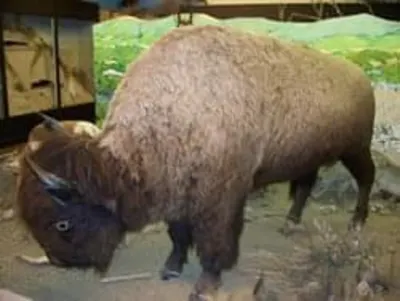
Bison can stand up to six feet tall, with females weighing up to 900 pounds and males up to a ton. They have a distinctive shoulder hump and short, curved black horns that can reach two feet in length. As herbivores, they feed on grasses and sedges. Bison live in groups—females and calves in one, males in another—until mating season when males join the females. They have one calf per year, born in spring, weighing up to 50 pounds. Wild bison live around 20 years, while those in captivity often live longer.
Fun Fact - Despite the bison being so big they can actually run very fast when they need to.
The Bison in our exhibits name is Frank. Click the link below to learn more about his story.
The Pronghorn Antelope
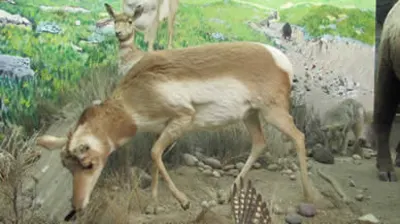
These animals are all very similar in sizes, the only thing that differs a lot is the horn size as the males’ horns are larger than the females. A male’s horns are around 10-12 inches long. They are about 4.5 feet long, 3 feet tall, and weigh between 90-150 pounds. Pronghorns travel together all the time. Reproduction is very high with pronghorns so normally they end up having two offspring. Fun fact, pronghorns are the second fastest land mammal in the world.
Fun Fact - The closest living relative to the antelope is the giraffe.
The Bobcat
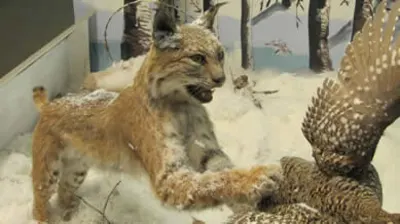
The bobcat is very similar to the Canada lynx but can be told apart by the bobcats’ small feet, short tufts of hair on its ears, and bobbed tail. Bobcats vary in size being anywhere from 5-18 kg, males being larger than females. Bobcats also breed once a year and have a 60-day gestation period, they can have up to 4 babies. The lifespan of a bobcat is about 1 year.
Fun Fact - They are actually names after their tails since they look “bobbed” or cut off.
The Raccoon
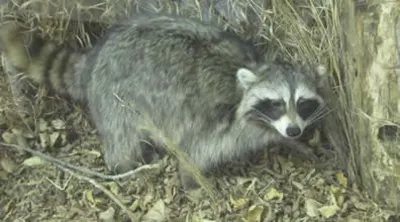
Raccoons are easily recognized by their black face mask and ringed tail. They are nocturnal but can adapt to urban environments. They measure 60–95 cm in length and weigh 5–12 kg, with males being heavier. Raccoons do not hibernate but store fat to stay warm in winter. Their front paws are highly dexterous, similar to human hands. They reproduce once a year, with mothers giving birth to up to seven kits. In the wild, raccoons typically live 3–5 years.
Fun Fact - The raccoons black masks not only look cool but they actually help them to see more clearly.
The Black Squirrel
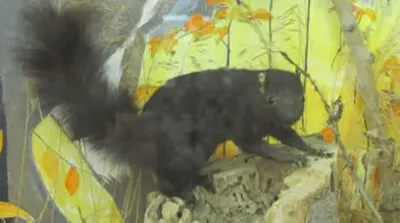
The black squirrel is either a Eastern Grey Squirrel or a Fox Squirrel. These squirrels are more likely to be seen in Ontario. Female squirrels typically give birth to litters of 1 to 6 babies. Baby squirrels reach maturity and leave their nests to find their own homes at around 9 months. These types of squirrels usually have a lifespan of 5 to 10 years.
Fun Fact - This squirrel is either a grey squirrel or a fox squirrel because they have a condition known as melanism which turns them a deep black earning them the name of the Black Squirrel.
The Whitetailed Deer
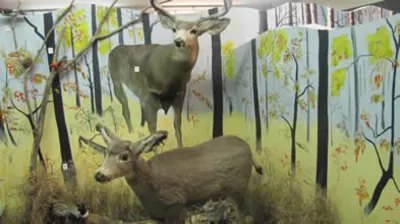
The white-tailed deer is a herbivore identified by white markings on its throat, around its eyes and nose, belly, and the underside of its tail. Males weigh 150–300 pounds, and females 90–200 pounds. They mate once a year and give birth to 1–3 fawns after about six months. Mothers hide their fawns while foraging, and fawns may stay with them up to 2 years (males usually leave after 1). White-tailed deer are fast runners, reaching speeds up to 30 mph, and are also strong leapers and swimmers.
Fun Fact - The white-tailed deer can jump higher than 8 feet.
The Lynx
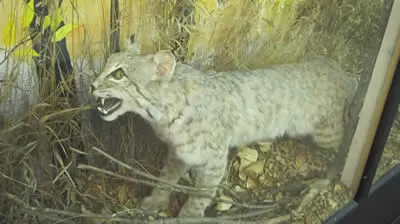
The Canada Lynx is about 20 inches tall, weighs around 20 pounds, and is adapted for snowy environments with furry, wide feet. It has long black ear tufts and a short, black-tipped tail. Lynx primarily hunt snowshoe hares but may eat other small animals when hares are scarce. They are solitary and mostly nocturnal. Females raise one litter per year, usually with 2–3 kittens, though up to 8 is possible, with only half surviving the first year. In the wild, lynx can live up to 14 years, and up to 26 years in captivity.
Fun Fact - The coat of the lynx changes colours as the climate changes.
The Magpie
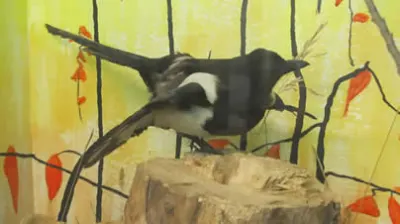
Magpies are 45 cm black and white birds with an iridescent blue-green tail. Females build round twig nests cemented with mud, taking up to 40 days. Their diet includes insects, seeds, small vertebrates, and other birds’ eggs. Magpies are monogamous, mating for life, and typically lay 4–8 eggs per clutch, though some lay up to 13. In the wild, they live an average of 4–6 years.
Fun Fact - Most of the birds in our gallery were taxidermied by the local high school students.
The Great Blue Heron
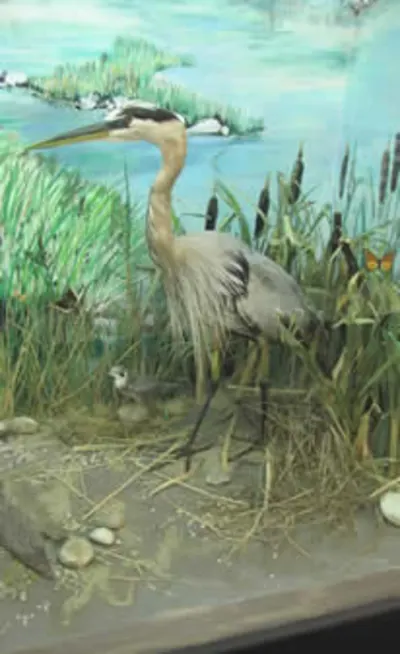
The Great Blue Heron is the largest heron in North America, with a wingspan of up to 2 meters and a height of about 1.4 meters. Males are slightly larger than females, weighing between 2.1 and 3.3 kg. They have Gray-blue wings, long necks with white to rust-red colouring, black crowns, long legs, and pointed yellowish beaks. They nest in large groups called rookeries, often near water, with some rookeries hosting over 500 birds. Nests can be up to 1.2 meters wide and 1 meter deep. Great Blue Herons fly at speeds of 32–58 km/h, breed once a year, and lay 2–7 eggs. Both parents incubate the eggs, which hatch in 25–30 days. They typically live around 15 years, with the oldest known individual reaching 23 years.
Fun Fact - A great blue heron can make their nests up to 100ft off the ground and can range from 5 to 500 nests per colony.
The Beaver
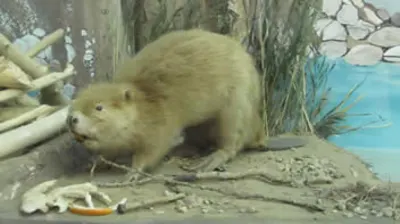
The beaver is the largest rodent in North America and the second largest in the world, known for its flat, scaly tail and adaptations for life in water. These include webbed back feet, waterproof fur, and strong chisel-shaped teeth. Beavers build dams and lodges in bodies of water, creating ponds for protection and shelter. They live in family groups of up to eight and store fat in their tails during winter. Beavers are monogamous, mating once a year with litters of 1–9 kits. They communicate through body language, sounds, scent marking, and tail slapping.
Fun Fact - A beaver can hold their breath for up to 15 minutes underwater and they have a transparent third eyelid which protects their eyes when swimming underwater.
The Badger

The badger, a member of the weasel family, is a nocturnal, muscular animal with strong jaws and large claws used for digging. It has a flat body, short legs, a broad head, and a grayish coat with a distinctive white stripe from nose to back. Badgers are 23 cm tall, 42–76 cm long (excluding a 10–16 cm tail), and weigh 9–26 pounds. They are omnivores but mainly eat rodents. To prepare for winter, they build up fat in late summer and fall. After a 6-week gestation, they typically give birth to 2–3 young.
Fun Fact - The badger is the mascot for most of the sports teams here in town.
The Cougar
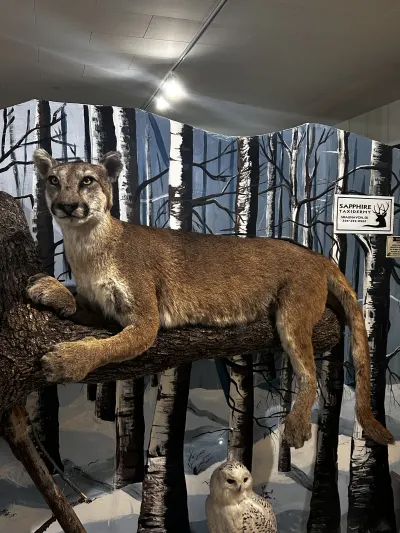
Cougars range in colour from pale buff to reddish brown, with dark ears, a tail tip, and white rump and belly. Kittens are born spotted but lose their spots by one year. Adults weigh between 77 and over 220 pounds. They typically inhabit areas suitable for white-tailed and mule deer. Cougars usually breed in winter, with a 90-day gestation, giving birth to 1–3 kittens, occasionally up to 6. They live about 10 years in the wild and up to 21 years in captivity.
Fun Fact - The cougar has multiple names, they have more than 40 in English alone.

